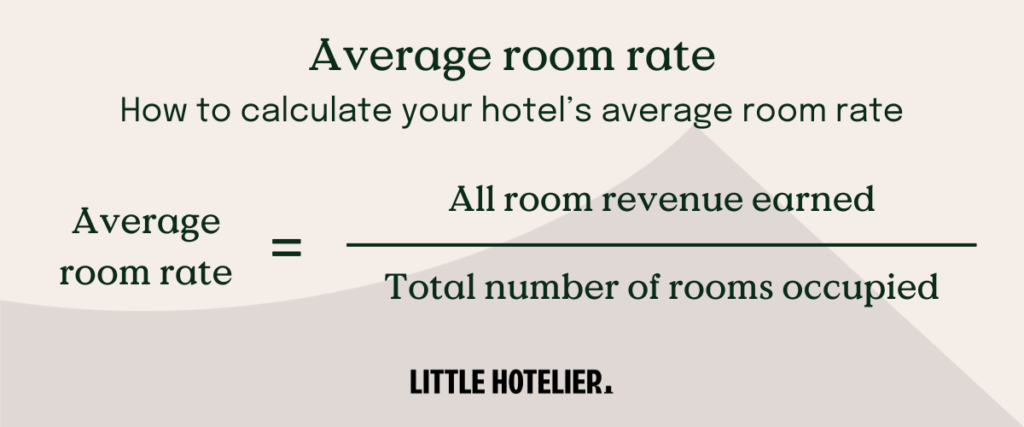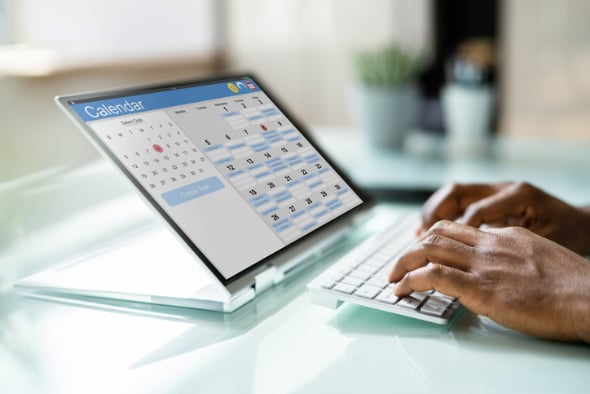What is the meaning of average room rate?
Average room rate is a measure of the average rental income of a paid and occupied room during a specific time period. It is a key performance indicator (KPI) in the hotel industry.
In an increasingly competitive sector, many B&Bs and boutique hotels are turning to revenue management to drive performance and profit growth. If you don’t get on the revenue management bandwagon soon, you risk falling behind the pack.
We’ll run through two key revenue metrics for B&Bs – average room rate and RevPAR. Also known as average daily rate, average room rate tells a hotel how much revenue they are generating on a per room basis. RevPAR, meanwhile, is a slightly more nuanced metric defined as revenue per available room.
In this guide we’ll look at why you need them and how to calculate them, as well as offer our expert advice on how to improve your performance in each area.
Boost your hotel's average room rate
Your average room rate can be calculated and improved with easy-to-use software built for small accommodation providers.
Learn moreWhat is the average room rate formula?
Average room rate is a powerful metric, so one might assume that a complex formula is used in order to come up with this pivotal number. Surprise! It’s actually pretty simple.
The formula to calculate your average room rate is:
Rooms revenue earned / Number of rooms sold
Of course, when you are using this formula, you need to exclude any rooms that are complimentary or rooms that are currently being occupied by staff members.
What is an example of average room rate?
Let’s say that you run a mid-sized, 15-room hotel. It’s Saturday night, so a good percentage of your rooms are occupied – let’s say 12. You charge a range of rates depending on the size, luxury and amenity of each room, but the total revenue for all 12 on this particular night is $3000.
Plugging those number into our average room rate formula, we get:
$3000 / 12 rooms = An ARR of $250
For an even more accurate idea of ARR, you might consider including any rooms that didn’t generate revenue, but were nevertheless unavailable – those that may have been complimentary, or used by overnight workers. If two of your rooms were used in this way, our example formula might look like this:
$3000 / 14 rooms = An ARR of $214

What is the difference between ADR and ARR in hotels?
Essentially, average daily rate (ADR) and average room rate (ARR) are different names for the same metric.
Some hotels, however, choose to differentiate these measurements by using ADR when looking at a specific day or moment in time, and ARR when looking at an average over a week, a month or more.
If you use ARR in this way, here’s how to calculate average room rate:
Rooms revenue earned over a given period / Total number of nights sold over that period = ARR
Why is revenue management important for B&Bs?
Revenue management is the art of managing rates and availability while keeping an eye on all the different key performance indicators (KPIs).
Big hotels and groups usually have dedicated revenue managers to create effective revenue management strategies. Small players like you don’t have this luxury – but that doesn’t mean it has to be the chink in your armour. B&B operators can be just as savvy when it comes to the numbers; all you have to do is know your formulas.
Knowledge is power and your property can learn to use available information to effectively manage your revenue strategy.
So, what revenues can you expect as a bed and breakfast host? The answer varies a great deal, depending on:
- The number of guest rooms in your B&B
- The seasonal (or not seasonal) nature of your locale
- The length of time you’re in operation
- How creatively you promote your business
- How hard you want to work!
There are hundreds of metrics, formulas, and key performance indicators in the revenue management world, but we don’t want to overwhelm you, so this article focuses on the essentials. Here are two success metrics you must use to see how well your small property is doing:
- Average room rate (or average daily rate)
- Revenue per available room
Now, let’s learn even more about them!
Key metric 1: Average room rate or Average daily rate
So, why do you need to know your ADR?
ADR is one of the most critical metrics because it measures the average price that a guest pays per room at your hotel. It allows you to measure and compare the room revenue generated during a specific period of time versus the amount of room revenue paid for by guests and the volume of occupied rooms at the property.
By understanding where your ADR is at during peak seasons and slow seasons, you can create promotional campaigns that can help drive traffic and increase revenue during these periods. It also provides insight into how you stack up against the local competition. This in turn allows you to maximise your income during the peak times of the year and manage your assets during the quiet seasons.
Average room rate calculator
Looking for an easy way to work out your ARR/ADR? Here’s how to calculate average room rate in a few clicks: use our average daily rate calculator!
Calculate your hotel's ADR easily
Just enter your total revenue over 30 days and the number of rooms at your property then you'll see your hotel's average daily rate.
Use free ADR calculatorKey metric 2: Revenue per available room
Revenue per available room (RevPAR) has long been considered the most important figure to look at when calculating the financial performance of accommodation. It tells you the revenue per available room and creates a relationship between rates and occupancy to understand how your B&B is performing.
Without tracking it, small accommodation providers will find it difficult to know how well they’re doing, and how to improve.
Here’s everything you need to know about RevPAR and how to maximise it at your B&B.
Room revenue formula
It can be calculated in two ways:
- Multiply average daily rate (ADR) with occupancy – this is the most popular method
- Divide the total revenue of a set time period by the number of available rooms in that period
You will calculate your RevPAR according to a specific point in time (day, month, or year), and compare it across the same time periods (for example, RevPAR across Fridays or Christmas holidays).
It’s difficult to say what a “successful” RevPAR is, as it really depends on the market, and is based on demand and other factors.
While it is considered accurate, this example shows us some limitations. If a hotel sells 50 rooms for $20, or five rooms for $200, the revenue is $1000 for a consistent RevPAR of $20. However, this doesn’t mean the net operating income of the hotel will be the same in both cases given how many other factors may come into play.
Total room revenue formula
Given the limited abilities of building strategies based on RevPAR, a new metric has made its way into the industry. Total revenue per available room (TrevPAR) takes a more meaningful look at the profitability of the hotel by taking into account the total revenue of the property including the bar, room service, breakfast etc. It is calculated by dividing total revenue by the number of available rooms.
Given you have the capability to accurately measure your pricing and revenue data, TrevPAR will give you many more options in how to conduct your revenue management strategy. You can:
1. Analyse the geography of your guests
Was the TrevPAR higher or lower depending on the demographic that was staying in a particular month? If, for example, TrevPAR increased with greater numbers of guests from Europe, or more specifically a country in Europe like Switzerland, you can target to increase the share from that market. Did the increase come from your rooms or amenities?
2. Analyse other segments
As with the geography, you might look at what is influencing increased revenue and how to capitalise on it. Could it be that women produce more revenue than men, or families more than other leisure groups?
3. Analyse the performance of amenities
Was TrevPAR up in summer? Perhaps it’s because you have an outstanding pool area. Was it up in winter? Maybe your heated spa is attracting more guests.
4. Be more accurate with pricing
By taking in the big picture, you can be informed about how much you need to be selling your rooms for and how this should change throughout the seasons.
Other hotel room revenue terminology
We did promise not to overwhelm you with metrics, but we couldn’t resist leaving a few more here for you to get familiar with. These are purely descriptive – we’ll give the formulas a rest… for now.
Market penetration index
This metric can be used to compare your success to other competing properties in the local market. The market penetration index, or MPI, will indicate your share of the bookings within the market. It allows you to understand how many guests are selecting your hotel versus another, and can help you adjust your marketing strategy to capture a higher volume of your target market.
Revenue generation index
The revenue generation index, or RGI, is a metric that allows you to compare your property’s RevPAR with the RevPAR of your competition in the local market. It is calculated by dividing your hotel’s RevPAR by that of the total market RevPAR. If the result is one or greater, you are generating a favourable portion of the market revenue. If it’s less than one, you will want to consider options to help capture a greater share of the total market revenue.
Gross operating profit per available room
This is a powerful metric, as it allows you to understand your hotel’s success across all levels. Known in the industry as the GopPAR, it allows you to identify which areas of your hotel generate the most revenue – and does not limit you to your revenue generated per room.
Marketing cost per booking
The marketing cost per booking metric, or MCPB, gives you an idea of how much you are spending to generate bookings from individual distribution channels. To calculate this metric, you must identify the distribution costs for that channel and subtract those costs from the booking amount that the guest pays. You will want to focus your efforts on the least expensive distribution channels to maximise profits.
Obviously, it’s hard to take on and monitor all of these metrics—particularly if you’re new to revenue management—so it’s important to focus on the ones you can control and impact with new strategies in order to maximise your revenue.
Common room revenue pitfalls
There are three common RevPAR mistakes that small accommodation providers make; avoid these at all costs!
Too much reliance on OTAs
Don’t allocate too many rooms to an online travel agency. They entice travellers with their discounts, and while it will increase your occupancy rate in the short term, you will lose money in the long run because of how much it costs you to service that room.
Learning how to strike a balance between direct and third party bookings is essential.
Underselling your rooms
Don’t try to charge less for rooms in an attempt to attract more guests. Instead, increase the perceived value of your room by adding additional extras.
You may find that by charging a higher rate and having fewer guests, you will actually increase your revenue (and service your guests better).
Spending too much
Try to reduce waste in your spending, especially when it comes to electricity. There are some ways to reduce your carbon footprint and save money at the same time – all without compromising the guest experience.
Another area to be aware of is breakfast items. Do you find that you’re always over-stocked and much of the bread goes to waste? Assess how much you really need so that the bread doesn’t go in the bin (along with the cash you spent on it).
Top three ways to increase your average room rate
The higher your average room rate, the more you earn, the more money you have to grow your hotel business… if only it were that simple! As an independent hotelier you need to find a way to increase your average room rate while retaining, and hopefully growing, the number of guests you attract.
This is quite the challenge, but here are three proven strategies to do just that.
1. Implement length of stay restrictions
This is still the best way to increase revenue per room!
- Minimum length of stay (minLOS) can be applied when you anticipate a period of high demand followed by low demand. You accept longer duration stays and reject shorter duration stays for arrival. It helps you to increase occupancy during the slow period that follows (so that stays in the high demand period “spill over” into the less demanding period).
- Maximum length of stay (maxLOS) can be applied when you expect to be able to sell out rooms at higher rates. You don’t accept reservations at specific discounted rates for multiple night stays extending into the sold out period. Guests who want to stay beyond the maximum length of stay period can be charged rack rate for subsequent nights.
It is best to implement minimum LOS restrictions when you are expecting a period of high occupancy so that the period after remains lucrative. This means busy periods will spill over into quieter times.
Maximum LOS should be implemented when you plan to sell rooms at higher rates. You shouldn’t accept discounted rates for multiple night stays during this time, and guests who want to stay beyond max stay can be charged a high rate.
Note that with all of the above, you need to be careful. If there isn’t sufficient demand, or if these tactics are poorly executed, it could have a negative effect on your bottom line.
2. Review room type attributes
See if you can increase revenue by adding new room type levels based on attributes like an excellent view, a balcony, or a big bath.
3. Enhance your offering
Increase room rates by giving guests access to exclusive perks that increase the perceived value of the rooms. For example, free shuttle to and from the airport, free pram hire, and free breakfast.
By Dean Elphick
Dean is the Senior Content Marketing Specialist of Little Hotelier, the all-in-one software solution purpose-built to make the lives of small accommodation providers easier. Dean has made writing and creating content his passion for the entirety of his professional life, which includes more than six years at Little Hotelier. Through content, Dean aims to provide education, inspiration, assistance, and, ultimately, value for small accommodation businesses looking to improve the way they run their operations (and live their life).
Table of contents
“Our accommodations are perfectly taken cared of, thanks to Little Hotelier. It's now easier to get real-time info! Payments are easily traced too.”
General Manager, Marina View Chalets









Craig Fisher,
Company Manager
Sun Worship Eco Villas